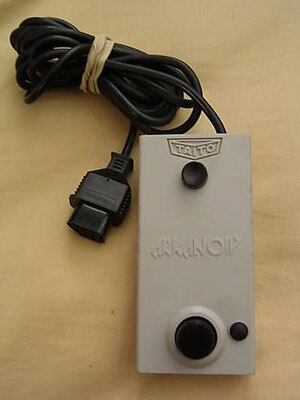| Revision as of 22:34, 12 April 2013 editTJ Spyke (talk | contribs)93,344 edits cleanup← Previous edit | Revision as of 15:15, 24 November 2013 edit undoChaheel Riens (talk | contribs)Extended confirmed users, Pending changes reviewers, Rollbackers38,527 edits →Summary: wlNext edit → | ||
| Line 15: | Line 15: | ||
| The player uses the knob to move the paddle left and right at variable speed, like in a ]. A standard NES controller can be used for ''Arkanoid'', using the left and right directions on the ], although speed is constant. The Vaus, however, contains a ] and the faster the knob is turned, the quicker the paddle moves left and right. There is one button on the controller so that the player can launch the ball, fire lasers, and access the options menu. | The player uses the knob to move the paddle left and right at variable speed, like in a ]. A standard NES controller can be used for ''Arkanoid'', using the left and right directions on the ], although speed is constant. The Vaus, however, contains a ] and the faster the knob is turned, the quicker the paddle moves left and right. There is one button on the controller so that the player can launch the ball, fire lasers, and access the options menu. | ||
| The Vaus was offered for sale packaged with Arkanoid in 1986, but neither the game nor the controller were available individually for purchase. It is one of only a few NES games that came in a non-standard box due to an accessory (''Stack-Up'' and ''Where in Time is Carmen San Diego'' are others). | The Vaus was offered for sale packaged with Arkanoid in 1986, but neither the game nor the controller were available individually for purchase. It is one of only a few NES games that came in a non-standard box due to an accessory ('']'' and '']'' are others). | ||
| A similar controller was packaged with the ] releases of ''Arkanoid'' and '']'', although the coloring varied from the US version. The Famicom Vaus for Arkanoid was black plastic with red buttons. ''Arkanoid 2's'' Vaus conroller was blue with green buttons, and also featured a controller port on top. This port was designed to accept another Vaus, enabling 2-player multiplayer.<ref>http://www.gamespot.com/nes/action/arkanoid2/index.html</ref> The US distribution, released only for the ] in 1997,<ref>http://www.gamespot.com/snes/action/arkanoiddohitagain/index.html</ref> did not have a dedicated controller. | A similar controller was packaged with the ] releases of ''Arkanoid'' and '']'', although the coloring varied from the US version. The Famicom Vaus for Arkanoid was black plastic with red buttons. ''Arkanoid 2's'' Vaus conroller was blue with green buttons, and also featured a controller port on top. This port was designed to accept another Vaus, enabling 2-player multiplayer.<ref>http://www.gamespot.com/nes/action/arkanoid2/index.html</ref> The US distribution, released only for the ] in 1997,<ref>http://www.gamespot.com/snes/action/arkanoiddohitagain/index.html</ref> did not have a dedicated controller. | ||
Revision as of 15:15, 24 November 2013
Video game| Vaus Controller by Taito | |
|---|---|
 NES (US/Europe) version Vaus. NES (US/Europe) version Vaus. |

The Arkanoid Controller, or Vaus, is an optional game controller for the Nintendo Entertainment System (NES) game Arkanoid which enhances the feel and play of the game.
Summary
The name Vaus is derived from the name of the ship that is controlled at the bottom of the screen, i.e. the paddle, which escaped from the mothership, called Arkanoid.
The Vaus controller is constructed from the same gray plastic as the standard NES controller and is roughly the same size and shape. It has one black button at the top, a black spinner below, an adjustment port, as well as an embossed Taito logo and a raised Arkanoid logo on the front. Unlike its arcade counterpart, the knob on the NES Vaus was not free-spinning; instead it had a limited turning radius. The point at which the knob stops coincides with the on-screen Vaus (paddle) hitting the left or right walls.
The player uses the knob to move the paddle left and right at variable speed, like in a video arcade. A standard NES controller can be used for Arkanoid, using the left and right directions on the D-pad, although speed is constant. The Vaus, however, contains a potentiometer and the faster the knob is turned, the quicker the paddle moves left and right. There is one button on the controller so that the player can launch the ball, fire lasers, and access the options menu.
The Vaus was offered for sale packaged with Arkanoid in 1986, but neither the game nor the controller were available individually for purchase. It is one of only a few NES games that came in a non-standard box due to an accessory (Stack-Up and Where in Time is Carmen San Diego are others).
A similar controller was packaged with the Famicom releases of Arkanoid and Arkanoid: Revenge of Doh, although the coloring varied from the US version. The Famicom Vaus for Arkanoid was black plastic with red buttons. Arkanoid 2's Vaus conroller was blue with green buttons, and also featured a controller port on top. This port was designed to accept another Vaus, enabling 2-player multiplayer. The US distribution, released only for the SNES in 1997, did not have a dedicated controller.
The packaging for the NES version advertises: "SPECIAL VAUS CONTROLLER INSIDE"
One other game, Chase H.Q. for the Nintendo Famicom, has an option which specifically supports the Arkanoid controller.
References
- http://www.gamespot.com/nes/action/arkanoid2/index.html
- http://www.gamespot.com/snes/action/arkanoiddohitagain/index.html